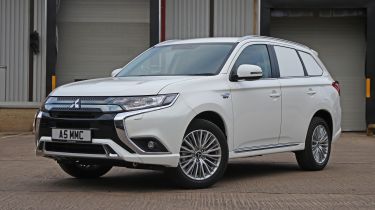Mitsubishi Outlander PHEV Commercial (2014-2021) review
The Mitsubishi Outlander PHEV Commercial is a unique vehicle, but doesn't get the same tax benefits as the passenger model

Pros
- Unique commercial vehicle
- Low everyday costs
- Large load area
Cons
- Tax costs
- Dull drive
- Rear visibility
There have never been many plug-in hybrid light commercial vehicles (LCVs) on sale. For a while there were only two: the Mitsubishi Outlander PHEV Commercial and the Ford Transit Custom PHEV van, but since early 2021, when Mitsubishi pulled out of the UK new-car market, the Outlander has only been available secondhand.
As the name suggests, it's based on the popular Outlander PHEV passenger SUV. Instead of a three-seat bench in the back, it has a long, flat load area that reaches from the front seats to the tailgate. The rear windows have also been blanked out so it qualifies as an LCV.
As well as having the back seats removed, the Outlander’s seatbelts, ISOFIX points and other seating components have been ditched, so you can’t retrofit the seats back in. The doors remain for access to the load area, although the electric window switches are blanks and the windows no longer open. That’s because while the glass is still there, it’s backed by carpeted material that adds sound deadening and protects the glass from damage.
Originally, the Commercial featured body-coloured ‘windows’, but the most recent version had black glass, making near-impossible to distinguish the Commercial from the regular SUV. But while the rear passenger area has changed, the Commercial is identical to the SUV in front and under the metal. That means it got the same range of updates the five-seater received in 2019, including a new 2.4-litre four-cylinder petrol engine, plus a bigger 13.8kWh battery and more powerful electric motors.
This setup promises an electric driving range of 28 miles, while top speed in electric mode increased and overall economy nudges 140mpg. As before, the Outlander PHEV Commercial has two charging connections, with the Type 2 connector taking four hours to top the battery up from a conventional domestic socket, and the CHAdeMO one around 25 minutes from a public charging point. An 'EV priority' mode allows you to drive the Outlander for as long as possible on the two electric motors, at speeds of up to 84mph.
As with the SUV, the Commercial delivers a comfortable driving experience, so in that regard it might be more appealing than an electric van. The interior is much more luxurious than a van's, too. When new, the Commercial was offered in Reflex trim only: standard kit includes an electronic parking brake, a rear camera, climate control, keyless starting and Apple CarPlay/Android Auto compatibility. Alloy wheels, a rear spoiler, rear parking sensors, automatic headlights, rain-sensing wipers, heated front seats, DAB radio and dual-zone climate control were also included.
The Outlander was designed for comfort rather than handling prowess, so while you do get a relatively plush ride – certainly better than any electric van – there's a vagueness to its handling that means it’s not suited to sporty driving. The suspension is also firm, as it has to counter the weight of the drive system.
The Outlander PHEV Commercial is a unique LCV that offers niche appeal to buyers. If you need a commercial vehicle with some off-road ability, or you’re a business user that wants something other than a van to promote their business, it's worth a look. But the way that UK business tax rates work at the moment means the Outlander PHEV isn’t as tax-efficient as its SUV counterpart. You at least benefit from the same low running costs, though. For a more detailed look at the Mitsubishi Outlander PHEV Commercial, read on for the rest of our in-depth review...



